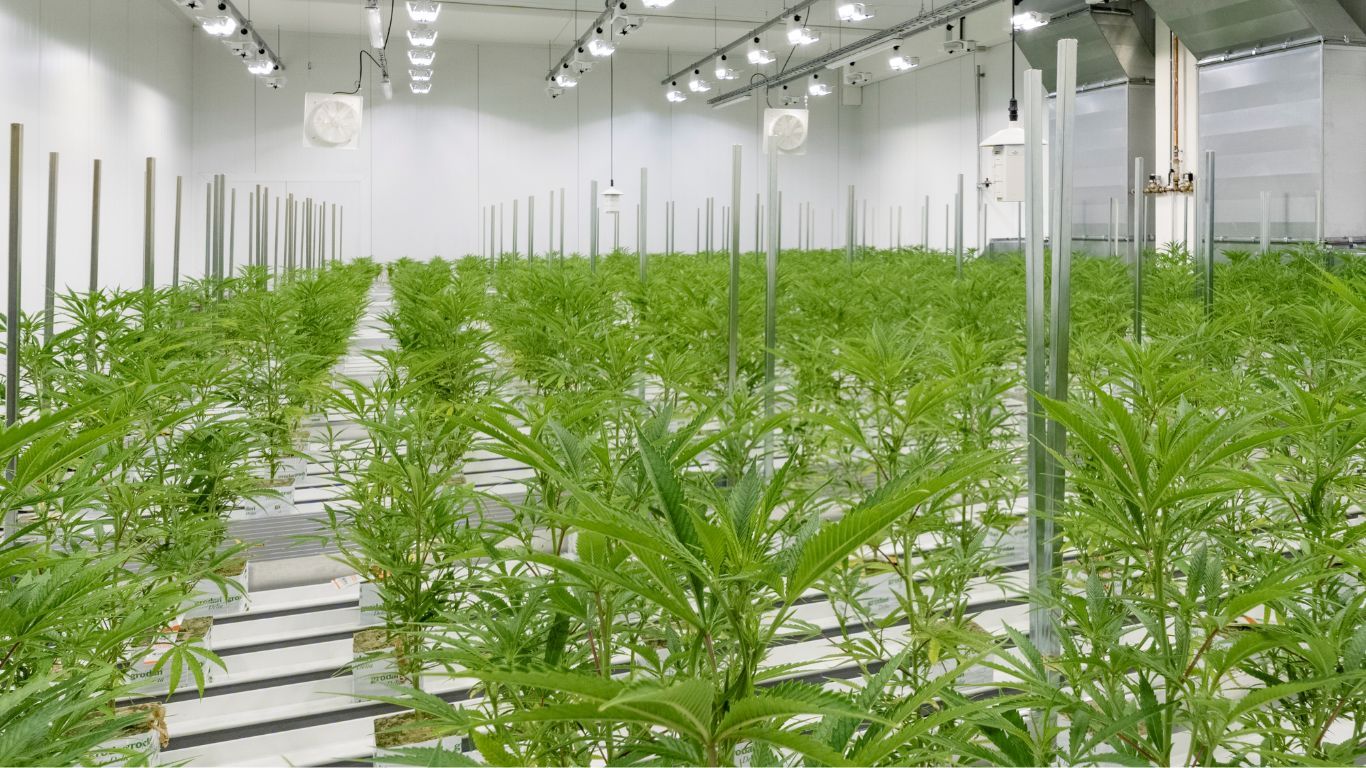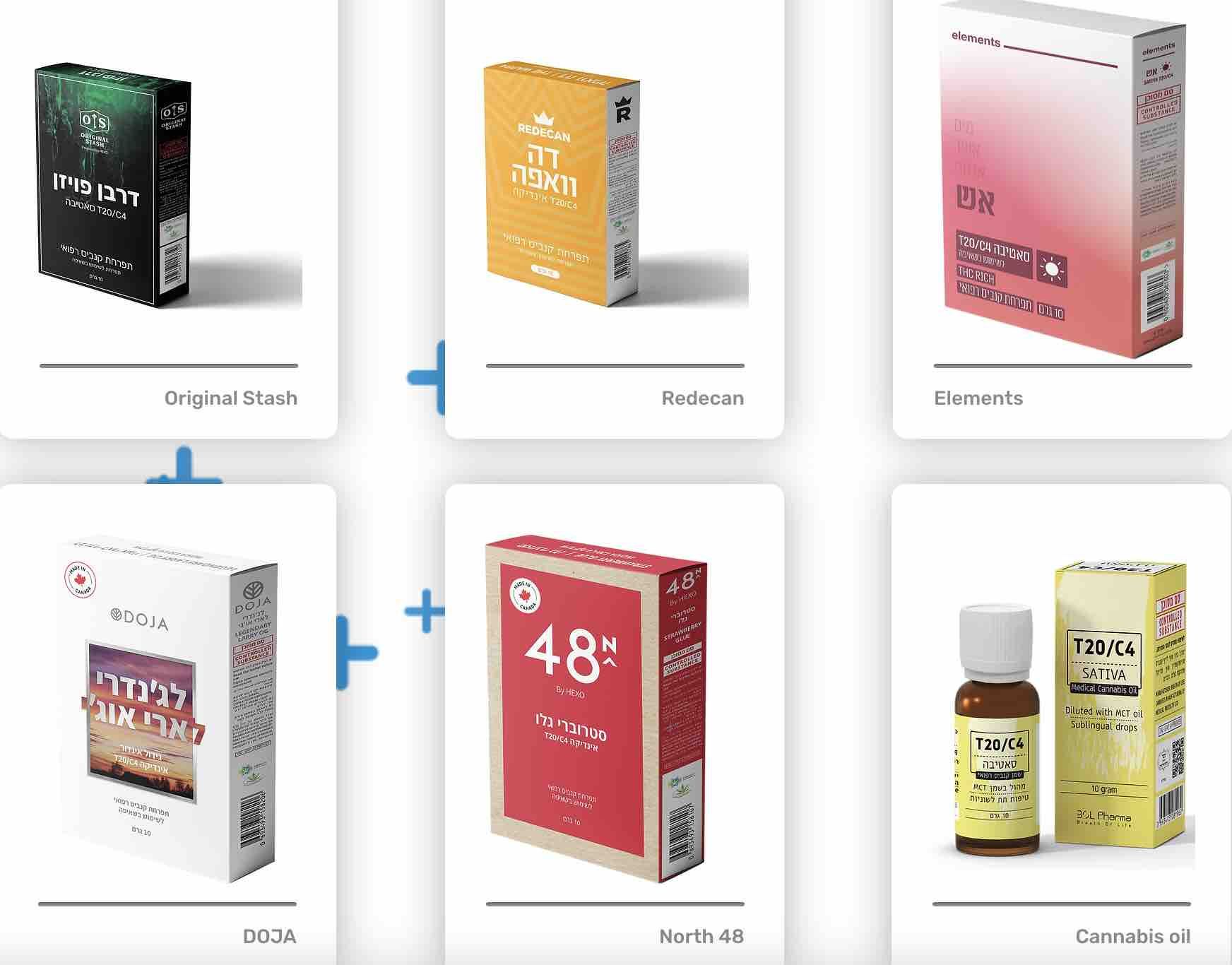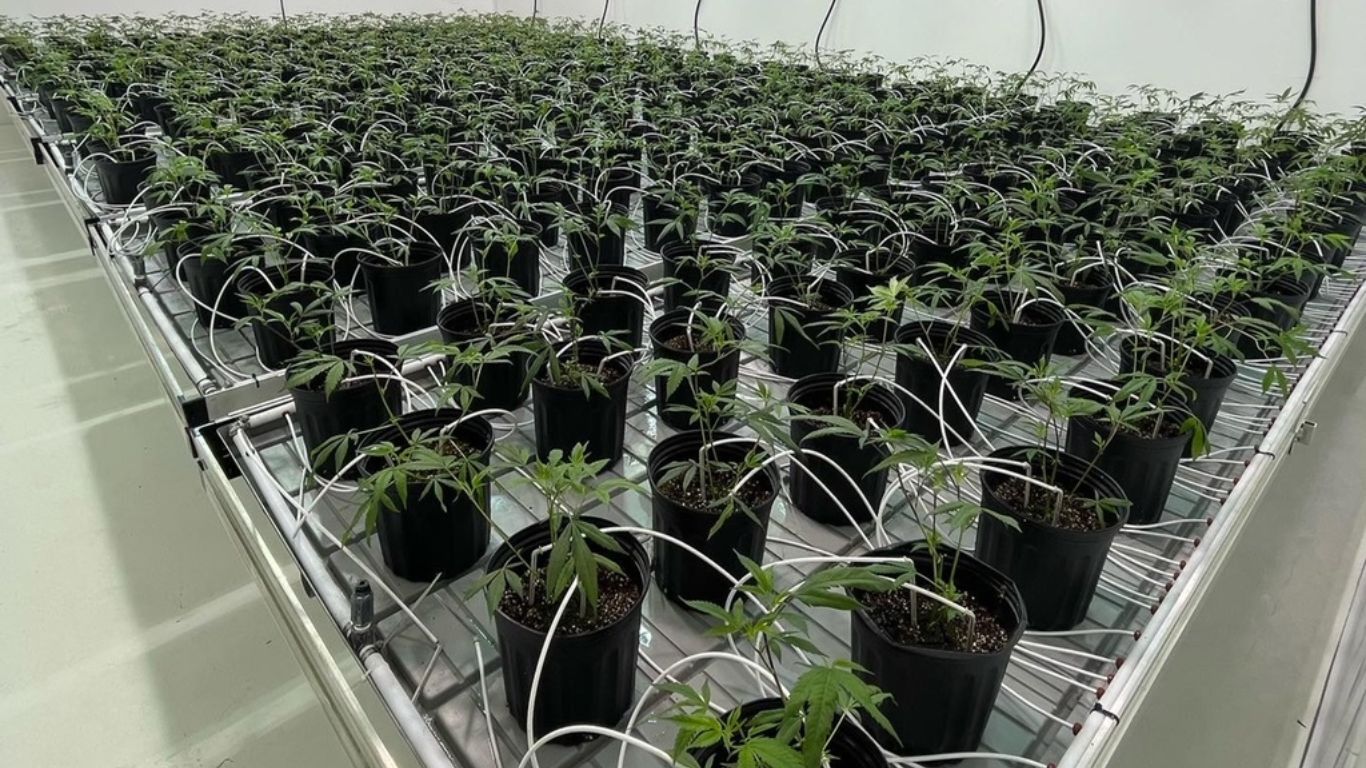
Very little has changed in Canadians’ perception of cannabis in 2021.
Canadians feel pretty much the same about most issues surrounding cannabis, cannabis use, and legalization as they did in 2020, according to the newest annual report from the Government of Canada.
The Canadian Cannabis Survey 2021: Summary is the fifth of its kind, with the first being released at the end of 2017. The survey asks a sample of Canadians a number of questions about cannabis, such as their knowledge and opinions about cannabis use and cannabis laws, awareness of legal sources, cannabis and driving, cannabis and pregnancy, cannabis use and growing in the home, and cannabis for medical purposes among several other topic areas.
Canadians opinions remained almost the same on nearly every question asked, from their level of awareness of health warnings on legal cannabis products to their opinions on cannabis and driving, cannabis use during pregnancy and breastfeeding, and the perceived risks of cannabis in comparison to things like alcohol and tobacco.
Canadians perceived cannabis use as having the second-lowest perceived risk, behind alcohol but better than smoking or vaping tobacco or nicotine. Occasional use of cannabis was also seen as more socially acceptable than the regular use of alcohol. Smoking and eating cannabis was seen as slightly more socially acceptable than vaping cannabis. Tobacco and e-cigarettes had the lowest level of social acceptability among these three main categories.
Overall, 89% of people thought that using cannabis could be habit forming. Those who used cannabis were a little more likely to say it can be habit forming. The majority of people (93%) who reported using cannabis in the past 12 months thought cannabis could be habit forming. A majority (88%) of those who did not use cannabis also thought cannabis could be habit forming.
Twenty-five percent of Canadians say they have tried cannabis in the past 12 months, a slight decrease from 27% in 2020. Men were once again more likely to use cannabis than women, but reported use by males did slightly decline, as did reported use from Canadians aged 16-24.
Fourteen percent of Canadians aged 16 years and older also reported that they used cannabis for medical purposes, but only twenty-two percent of those reported doing so with the authorization of a medical professional (“a document from a healthcare professional”).
People born in Canada are about two times more likely to consume cannabis than those who immigrated here, and use was about twice as high among those who identified as homosexual, bisexual, or “another sexuality” compared to those who identified as heterosexual.
People enrolled in school were more likely (35%) to report use than those who didn’t report being enrolled in school (25%). People who reported working at a job or business in the past week or have a job or business they were on vacation from reported cannabis use during the past 12 months were a little more likely to use cannabis compared to those who did not work at a job or business (28% vs 21%).
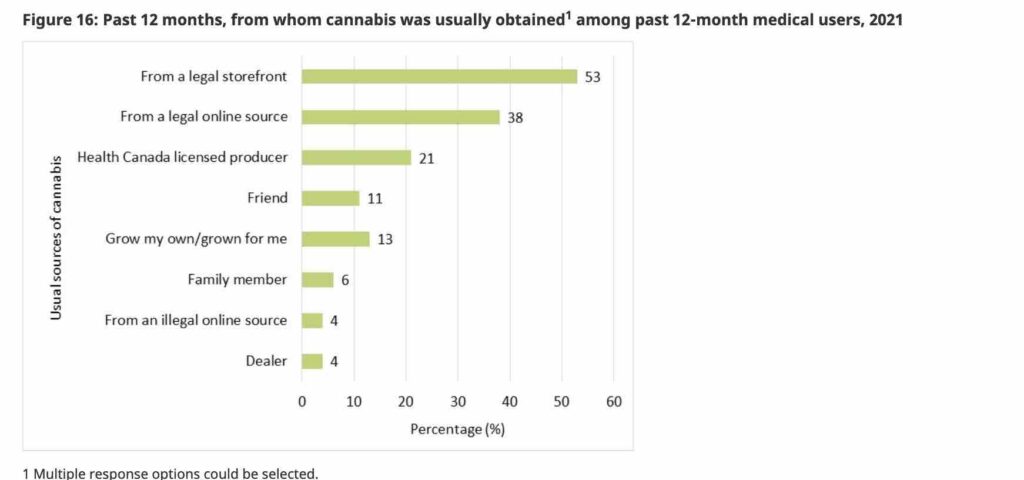
Those Canadians with a postgraduate degree or diploma were less likely to consume cannabis than those without, 17% to 24%.
Of those who reported using more cannabis because of the COVID-19 pandemic, Canadians under 25 reported a greater increase in use.
Twenty-five percent (25%) of people 25 years and older reported using more cannabis, compared to 46% of those aged 16 to 19 years and 40% aged 20 to 24 years. At the same time, 21% of people aged 25 years and older reported using less cannabis, compared to 27% of those aged 16 to 19 and 25% of those aged 20 to 24 years.
Once again, most Canadians who consume cannabis report using it less than one day a month, at 33% of consumers, while 19% reported daily use. Twenty-seven percent reported using it from one to six days per week.
Most cannabis users (72%) reported being stoned or high on a day of use for one to four hours while 15% reported being stoned on a day of use for five or more hours a day.
All of these figures are the same or similar to those in 2020.
The age of introduction to cannabis has also continued to increase slightly since legalization. In a 2017 survey, the average age of first introduction to cannabis was 18.6 years. By 2020 it was 20 years and in 2021 it was 20.4 years.
Cannabis is legal in provinces at different ages, either at 18, 19, or 21.
Smoking remained the most common form of consumption (74%), although this was down from 79% in 2020, while vaporizing it increased from 24% in 2020 to 28% in 2021. Cannabis edibles were the second most popular form of consumption at 54% percent. Those who reported drinking cannabis doubled from 2020, from 7% to 15%. Twenty-two percent reported using cannabis oil or capsules, a new figure in 2021.
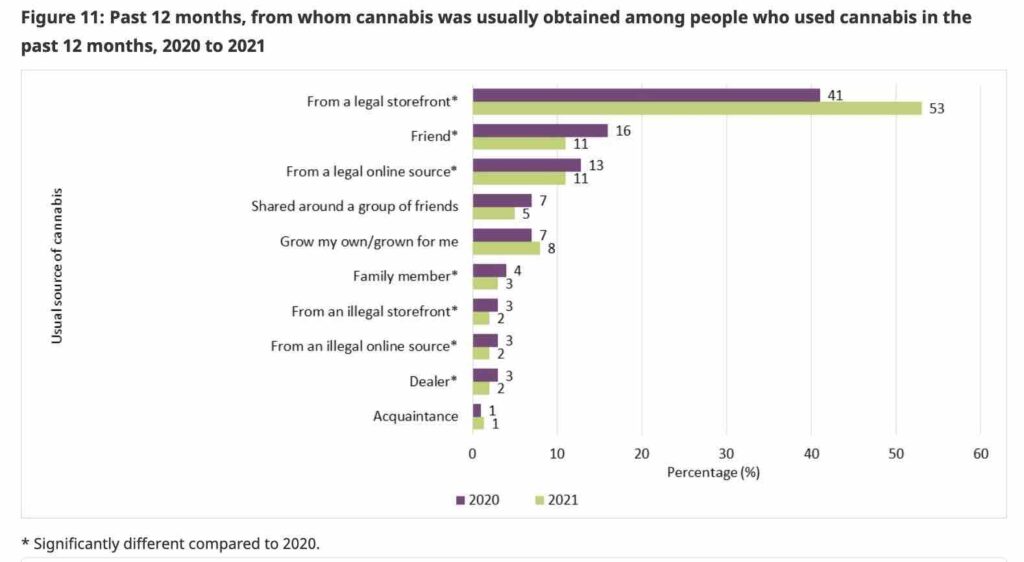
Of those who vape cannabis, vaping of cannabis oil increased from 60% to 68%, whale vaping dried cannabis flower lowered from 65% to 54%.
Men were slightly more likely than women to use cannabis flower or concentrates while women were a little more likely to use edibles and topicals.
Fifty-eight percent of Canadians who reported using cannabis said they would be more willing to publicly disclose whether they use cannabis, up from 51% in 2020.
Fifty-three percent reported that they had made a purchase from a legal storefront, an increase from 41% in 2020. People were less likely to get cannabis from a friend or from a legal online source, or from an illegal storefront or online source or “dealer”.
Of those who reported using cannabis, 43% said they only source it from the legal market, an increase from 37% in 2020. Sixty-three percent said they never use an illicit source compared to 55% in 2020.
A higher percentage (43%) indicated they always obtain from a legal/licensed source in 2021 than in 2020 (37%). There was also a higher percentage (63%) indicating they never obtain from an illegal/unlicensed source in 2021 compared to 2020 (55%).
Of those who purchase from the illicit market, most (59%) say they get it from someone they know, while twenty percent day they get it from an illicit online store. Another twenty percent report getting cannabis from a “dealer”. Only eleven percent report getting it from an unlicensed retail store, although it’s possible this number could be higher as some consumers are under the impression illicit stores are in fact operating legally.
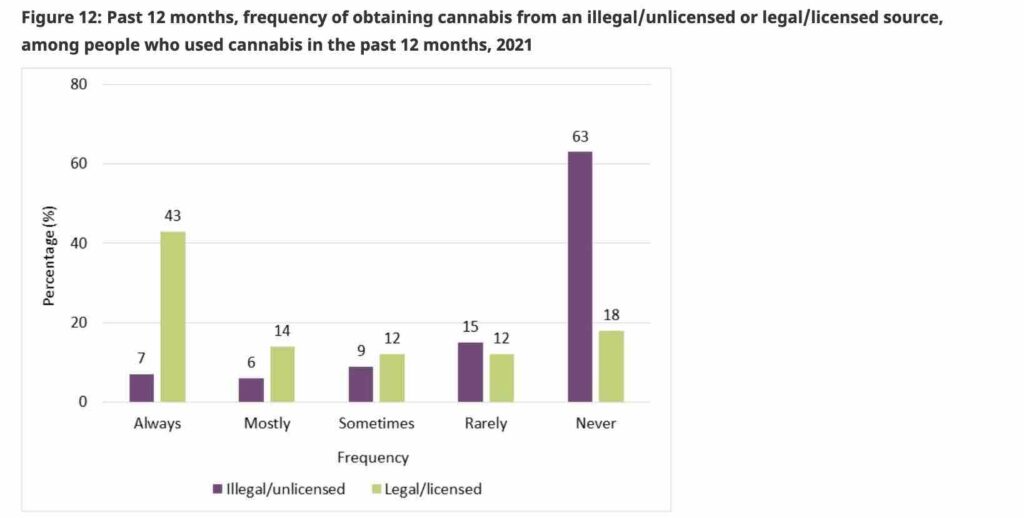
The average consumer spends from about $40-100 a month on cannabis.
Of those consumers who reported using cannabis for medical purposes, those who reported accessing it from legal storefronts increased from 44% in 2020 to 53% in 2021, and from a legal online source increased from 23% to 38%.
Another 21% sourced it from a licensed producer through the medical system. Thirteen percent said they either grew it or had it grown for them under a designated production licence (same as 2020).
Of those who obtained cannabis directly from a licensed producer, seventy-seven percent say they intend to continue to do so even with non-medical cannabis stores available.
Canada will continue to track this and similar data to gatherer a clearer picture of the impacts of cannabis legalization.










